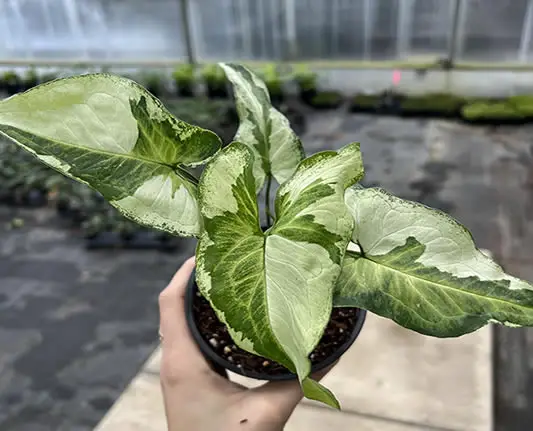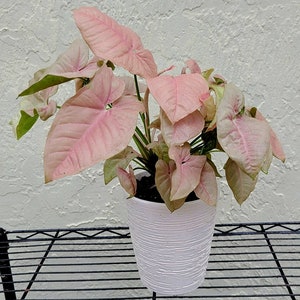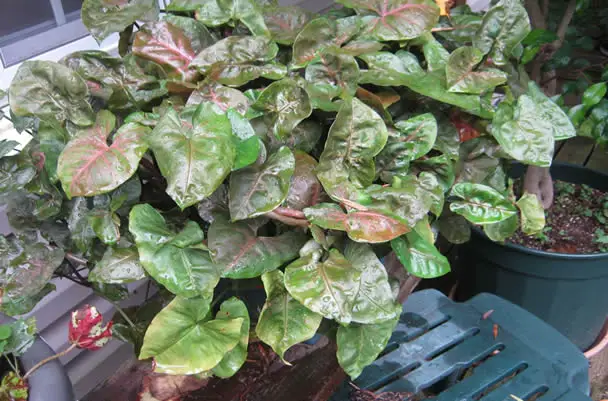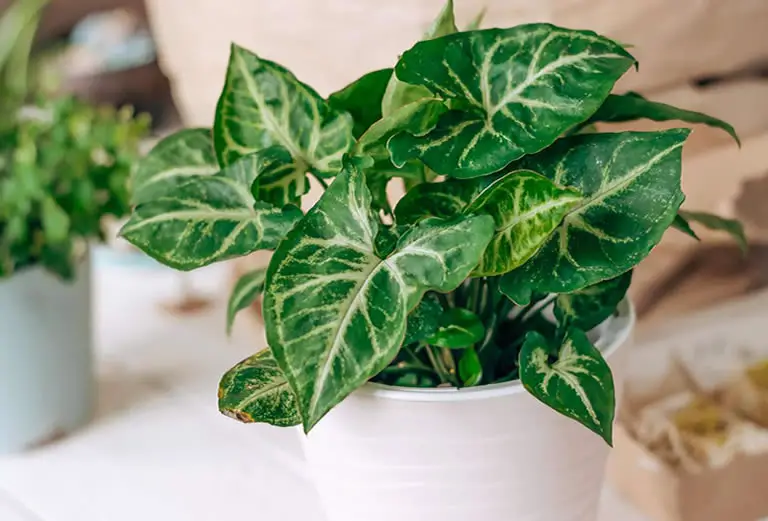The Arrowhead Plant (Syngonium podophyllum) is an adaptable, fast-growing houseplant known for its arrow-shaped leaves and wide range of striking colors. Whether trailing from a shelf, climbing up a moss pole, or staying compact in a pot, Syngoniums offer tropical vibes without demanding tropical-level attention.
Let’s walk through how to keep this versatile beauty thriving—and highlight the most popular types you’ll definitely want to collect.
Table of Contents
- Syngonium Podophyllum Basics
- Popular Syngonium Varieties
- Light Needs: Bright, Indirect Light Brings Out the Best Color
- Watering: Keep It Evenly Moist, Not Soggy
- Humidity and Temperature: Warm and Humid Is Ideal
- Fertilizer: Feed for Fast, Healthy Growth
- Soil and Repotting: Well-Draining Mix Works Best
- Pruning and Training: Shape and Support as It Grows
- Best Spot in the Home: Bright Rooms with Humidity
- Outdoor Care: A Shady Summer Companion
- Common Problems and Fixes
- Final Thoughts
Syngonium Podophyllum Basics
Native to Central and South America, Syngonium podophyllum is a tropical vine that grows under the canopy of dense rainforests.
In its natural habitat, it climbs up trees using aerial roots, and as it matures, its leaf shape shifts from simple arrowheads to more complex lobes.

It belongs to the Araceae family, and while it’s often grown as a small potted plant indoors, given enough time and support, it can become a bold, climbing houseplant.
With proper care, it grows quickly and rewards you with vibrant new foliage.
Popular Syngonium Varieties
Syngoniums come in a stunning variety of colors and patterns. Here are a few must-know favorites:
• Syngonium ‘Three Kings’ – A striking variety with creamy marbled leaves and soft green edges. It has a painterly, high-contrast look that stays beautiful even as it matures.
• Syngonium ‘Pink’ – Also called Pink Allusion, this variety features soft blush-pink foliage with green margins. It’s one of the most iconic colored types.
• Syngonium ‘Albo’ – A white-variegated beauty with unpredictable splotches and splashes across its green arrowhead leaves. Highly sought after and eye-catching.
• Syngonium ‘Pixie’ – A compact cultivar with small, lime-green leaves and creamy white centers. It’s ideal for small pots and terrariums.
• Syngonium ‘Mini Pixie’ – Even smaller than Pixie, this variety is excellent for tight spaces, desk plants, or grouped displays.
• Syngonium ‘Neon Robusta’ – A pink-toned cultivar with an almost iridescent sheen. New growth comes in hot pink and deepens as it matures.
• Syngonium ‘Confetti’ – Known for its soft green leaves speckled with pastel pink dots. It’s playful and unique.
• Syngonium ‘Maria’ – A darker variety with metallic undertones and reddish-bronze leaves that shimmer in the light.
• Syngonium ‘Berry Allusion’ – Pale green leaves with subtle pink veins and a soft pink tint throughout. Elegant and softly colorful.
• Syngonium ‘White Butterfly’ – A classic and easy-to-find variety with creamy white centers that fade into light green edges. Very popular for its delicate, airy appearance.
With so many colors and sizes to choose from, there’s a Syngonium for every style and space.
Light Needs: Bright, Indirect Light Brings Out the Best Color
Arrowhead Plants grow best in bright, indirect light.
Variegated and pink varieties especially benefit from more light to retain their colors.

Avoid direct sunlight—it can burn or fade the delicate leaves.
While they tolerate lower light, growth slows and color fades without enough light.
Rotate the plant every few weeks to encourage even growth on all sides.
Watering: Keep It Evenly Moist, Not Soggy
Syngoniums like to stay lightly moist.
Water when the top inch of soil feels dry, and reduce frequency in winter.
Avoid soggy soil, which can lead to root rot.
It’s better to underwater slightly than to overdo it.
Use distilled or filtered water if your tap water has high salt or fluoride content.
Humidity and Temperature: Warm and Humid Is Ideal
These tropical plants love humidity.
Keep levels above 50%, and they’ll grow faster and lusher.

Mist regularly, use a humidifier, or place your plant on a pebble tray. Average indoor temps between 60°F and 80°F are perfect.
Avoid cold drafts or air vents, especially during winter.
Fertilizer: Feed for Fast, Healthy Growth
Feed every 4–6 weeks during spring and summer with a balanced liquid fertilizer diluted to half strength.
A formula with an NPK ratio of 20-20-20 or 10-10-10 works well.
Fertilizing helps support fast growth and bright colors.
Skip feeding in fall and winter when growth slows.
Soil and Repotting: Well-Draining Mix Works Best
Use a light, well-draining potting mix—something formulated for tropical foliage or houseplants.
A blend of potting soil, coco coir, and perlite gives good balance.
Repot every 1–2 years, or when roots start circling the base.
Always choose a pot with drainage holes.
Pruning and Training: Shape and Support as It Grows
Prune regularly to control size and keep the plant bushy.
Pinch back long stems just above a node to encourage branching.

You can let it trail from a pot or guide it to climb a moss pole for a taller, more vertical look.
Trim yellow or leggy growth to keep your plant tidy and healthy.
Consider using healthy clippings for growing new plants as we outline in our article How to Propagate Syngonium (Arrowhead Plant) Easily at Home.
Best Spot in the Home: Bright Rooms with Humidity
Syngoniums thrive in living rooms, bathrooms, and bedrooms—anywhere with bright, indirect light and a bit of humidity.
They’re excellent for hanging baskets, plant stands, or trailing along a shelf.
Compact varieties are ideal for small pots, while climbing types love a pole.
Outdoor Care: A Shady Summer Companion
In USDA zones 10–11, you can grow Syngonium outdoors year-round in shaded, humid spots.
In cooler zones, place it outside in warm months when temps are above 60°F.
Choose a shady or dappled-light area and avoid hot, direct sun.
Bring it indoors before temperatures start to drop in early fall.
Check for pests and rinse off the foliage before transitioning.
Common Problems and Fixes
Yellow leaves often mean overwatering or poor drainage
Fix it by adjusting your watering schedule and using a pot with drainage holes

Brown leaf tips may result from dry air or low humidity
Fix it by misting regularly or adding a humidifier nearby
Faded colors typically mean the plant isn’t getting enough light
Fix it by moving to a brighter location with indirect sun
Leggy stems happen when light is too low or the plant isn’t pruned
Fix it by trimming back and offering more light
Drooping leaves usually indicate underwatering or dry soil
Fix it by soaking the soil thoroughly, then draining well
Final Thoughts
Arrowhead Plants are easy to love and even easier to grow.
With their quick growth, vibrant colors, and flexible form—whether trailing, climbing, or compact—they’re a perfect choice for any home.
Find a bright corner, keep the humidity up, and your Syngonium will reward you with lush foliage and endless new leaves.

